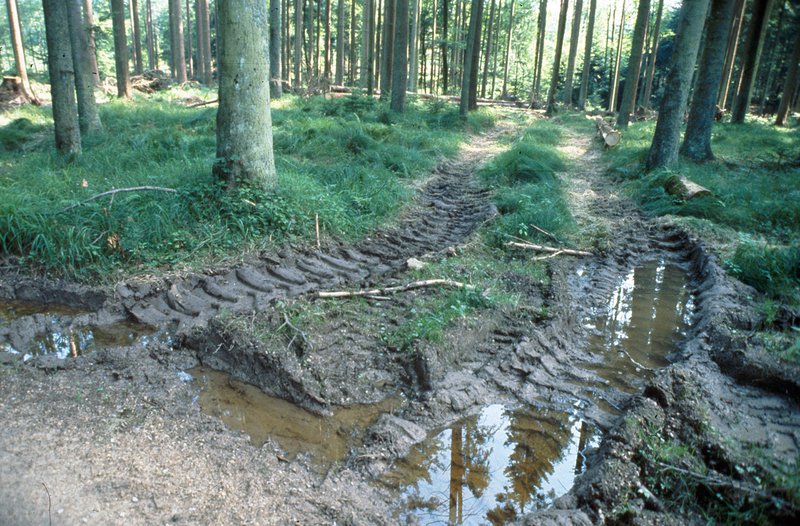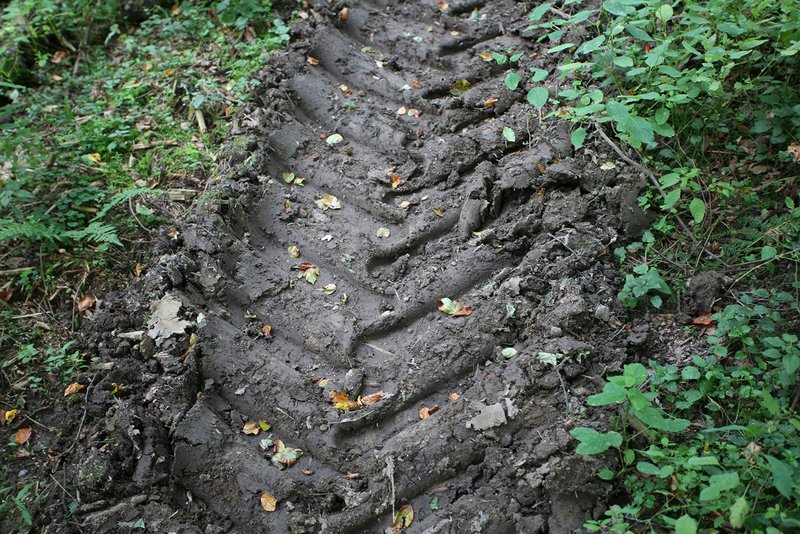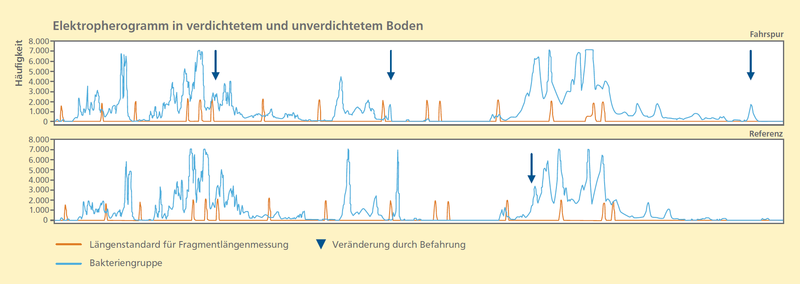In order to implement soil protection the people involved in every day forestry practice, as well as the authorities, are demanding guidelines and practical methods with which adverse effects on soil quality can be recognised and avoided. Soil microorganisms can indicate mechanical stress on soil, because they register the actual effects on the spot. Microorganisms are very useful as indicators for soil quality due to the functional relationship existing between the physical soil characteristics and the living conditions created by them, as well as the composition of the various bacterial populations living in the wheel tracks.
Our soils have been formed over thousands of years. They can however be destroyed in a much shorter time. Today dangers threaten our soils from many directions. The wheel track of a heavy harvester on wet soil is enough to damage a fertile soil. Therefore, forest soil protection is a very important issue, because damage which has already been done can only be repaired with a large amount of effort.
Natural soil regeneration takes a long time, fertile soil can rarely be replaced within a human life time. A fertile forest soil provides not only the basis for robust tree growth and timber production, but it also plays an important role in the ecological balance of nature. As an indispensible water reservoir for instance or a filter for drinking water.
A healthy forest soil also constitutes the largest reservoir of biological variety within a forest. One gram of forest soil contains up to 8’000 different microorganisms, twenty times more that in the soil of a ploughed field. The recycling of organic material is influenced to a large extent by an active soil microflora thus contributing to the vitality of the forest stand.
The loss of such a variety can have far reaching consequences for soil fertility. It can, for instance, affect litter decomposition and the formation of humus. Many of the extremely complex relationships and interactions taking place within the soil (which vary from soil type to soil type) are still not completely understood. This makes the protection of this non renewable resource exceptionally difficult.
Soil mircoorganisms as indicators of soil quality
Since the storm “Lothar” in December 1999, which caused a considerable amount of damage to Swiss forests, more attention has been paid to physical soil protection. In many places the hastily carried out clearing up operations after this storm left behind a considerable amount of wheel tracks (Fig. 1) which caused far reaching, long term changes in the soil structure. The compaction of soil rich in pores is enough to considerably affect the ecological functionality of the soil.
In order to implement soil protection the people involved in every day forestry practice, as well as the authorities, are demanding guidelines as well as simple practical methods with which the impairment of soil quality can be recognised and avoided. Physical parameters alone cannot characterize soil structure. Soil air characteristics, as well as biological parameters, are just as important. Today microbiological parameters are being recognised as soil quality indicators which are able to indicate short, middle or long term changes in soil quality. Microbiological soil parameters provide information about the effect the chemical-physical soil environment has on the biological activity and other processes being carried out in the soil. This information cannot be gained by using only chemical or physical analyses of the state of the soil.
The aim of this research is to look at the functional relationships between physical soil characteristics and the living conditions which are directly or indirectly influenced by them, including the amount, activity and composition of the various soil microorganisms. Intensive relationships between biological, chemical and physical processes in the soil take place amongst other things through the gas exchange.
Intact soil is made up of two parts, one part being made up of firm crumb like matter and the other of pores which allow air or water transportation. A damaged and limited pore system reduces the transport capacity for water and air. The fine pores are more often filled with water and because oxygen diffuses ten thousand times more slowly in water than in the air, then it will be released from the pores much more slowly. In compacted soil, in wheel tracks for instance, the gas exchange between the soil and the atmosphere is inhibited.
The consequences are oxygen poor or complete anaerobic conditions as well as a species displacement amongst microorganisms in favour of species which can survive under oxygen poor circumstances. This is reflected in the composition of the gases emitted from the soils into the atmosphere. When there is an oxygen deficiency the microorganisms meet their energy requirements through reduction processes rather than through combustion. Accordingly the percentage of nitrous oxide (N2O) will increase and under extremely reduced conditions the percentage of methane (CH4) will also increase.
Changes in microbial symbiosis in compact wheel tracks
In a joint project with the Technical University of Munich a clear, simple classification system of available wheel tracks based on visually recognisable morphological characteristics was compiled. This classification system differentiated between three types of soil mechanical wheel tracks.
To be able to document the distribution at various locations test areas were charted using the above classification system. Samples from different wheel tracks in the charted test areas and from test areas where wheel tracks were produced under controlled conditions provided the data basis. Samples were taken and the physical and microbiological parameters were recorded at points where typical characteristics were displayed. Threshold values above which forest soil should be able to regenerate should be able to be derivated from the changes in soil structure. These changes have an impact on the ecological functionality as well as the composition of the various microbial populations.
From soil samples (wheel tracks and non-disturbed reference samples) DNS is extracted (genetic substance of living creatures) and the structures of the microbial communities n the various wheel track types are verified using genetical analysis (T-RFLP;DGGE). Genetic patterns (Fig. 3 and 4) of the different wheel track types were compared using multivariate statistics (principal component analysis) (Fig. 5).
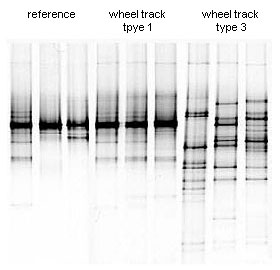
Fig. 4 - Band patterns (DGGE profile) of bacterial populations in compacted and non-compacted soils; each band shows a specific bacterial group, which plays a role in the nitrogen cycle in the soil. A difference can clearly be seen between the bacterial populations in the non-disturbed reference sample, wheel track type 1 and wheel track type 3.
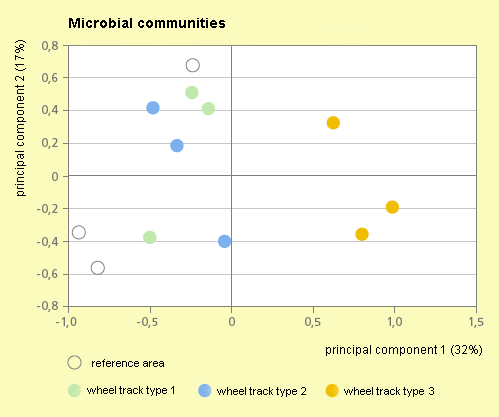
Fig. 5 - Depending on the type of wheel track the composition of the microbial communities shows varying clusters in the principal component analysis. Wheel track type 1 (circle: green) and 2 (circle: blue) very much resemble the samples from the non damaged reference area (circle: empty) the microbial populations in the wheel track type 3 (circle: yellow) are clearly different.
Bacterial groups, which show high mechanical pressure on the soil (indicators), are then identified by cloning and sequencing. At the same time groups of bacteria, which exist predominantly under either anaerobic or aerobic conditions are examined. In the centre of interest are not only bacteria which utilise nitrate, but also those which enrich the soil with nitrate. Both of these groups perform important functions in the soil and are very dependent on gas regulation.
Previous analysis on the trial areas in Messen (canton Bern) and Ermatingen (canton Thurgau) show that microbial communities did not differ between the wheel tracks of type 1 and part of the wheel tracks of type 2. However, the microbial communities in severely compacted wheel tracks of type 3 and part of the wheel tracks of type 2 were significantly changed in comparison to uncompacted soils (Fig 5.) These changes were in accordance to the modifications in the soil structural characteristics and the drastic reduction of the hydraulic conductivities.
These first results show that mechanical soil pressure caused by heavy harvesting machines does affect the microbial communities. Anaerobic conditions in the compacted wheel tracks favour bacterial species which are adapted to oxygen deficient conditions therefore changing the structures of the microbial communities. The results do however indicate that threshold values could be found above which soil functionality, at least at a low level, would remain intact and a chance of soil regeneration could exist.

